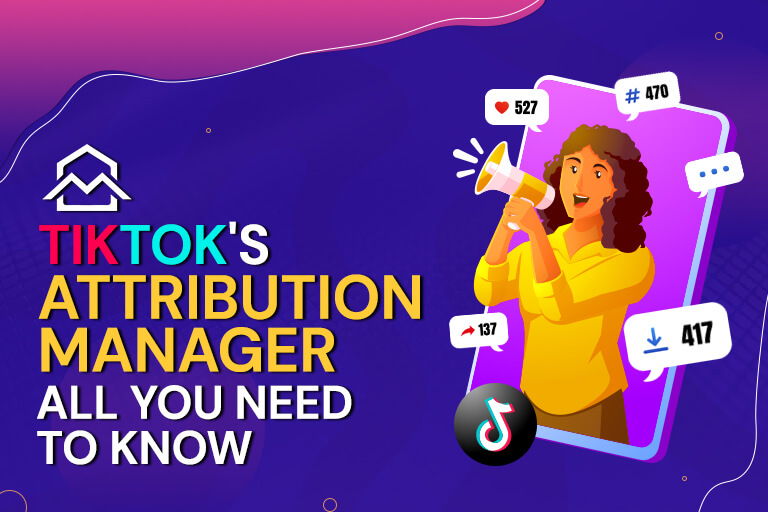
In an email sent directly to the House of Marketers team, TikTok announced that they will be switching to a self-attribution model for paid ads on their platform. Until recently, brands and advertisers had to rely on third-party mobile measurement platforms (MMPs) such as AppsFlyer and Adjust. But now, you can track app installs and other types of conversion events, thanks to the new model. The introduction of the new TikTok Attribution Manager means you can now track and attribute conversions directly on TikTok. This gives brands more insight into the performance of their campaigns. It also brings the platform in line with other major Self-Reporting Networks (SRNs) such as Facebook and Google.

TikTok’s Overview of The New Attribution Manager
Here’s what TikTok had to say about the new Attribution Manager and their move towards becoming an SRN:
“You may have heard from AppsFlyer that we are transitioning to self-attribution… just wanted to give some more detail here:
What is changing?
- Right now TikTok relies on MMPs to send conversion data to us which is then displayed in TikTok Ads Manager. This means that TikTok has to be the last touchpoint in order for us to receive a conversion from the MMP.
- Compared to all other ad networks — that claim credit if a click/ view occurred within their attribution window — we are underreporting the actual influence TikTok had in your marketing campaigns.
- With this change, TikTok Ads Manager will report any conversions that happened within the attribution window. We believe this will more accurately reflect the influence TikTok has on your conversion goals.
Benefits:
- More attributed events. Since TikTok will claim credit for interactions that occur within your attribution window, TikTok Ads Manager will likely see more conversions than before. However, please note the exact impact will vary from advertiser to advertiser.
- More signals for our downstream machine learning products. These increased attributed events will also be used in our downstream machine learning products across bidding, targeting, and optimization. This will likely result in better performance over time.
- Enables future-looking attribution solutions. Moving to a self-attribution network is the first step in a journey of unlocking additional, proprietary attribution solutions. While many are still work-in-progress, we may launch some features in the future. This includes privacy-first conversion lift studies, multi-touch attribution reports, and other products so you get the most from TikTok advertising.
- X-channel conversion reports are still available in the MMP. We know many advertisers use their MMP’s x-channel conversion data for making budgeting decisions and comparing ROI on different platforms. This report will still exist when we move to a self-attributing network so you can continue to use this report as normal.
Timelines & early access:
- While dates are fluid, we are expecting to start onboarding a small group of advertisers on June 15th and then continue the rollout over a few months.
- However, we are looking for early testers who want to work directly with the product & give feedback on the transition. If this interests you, please let me know and I can send over more information.”
The Problem With TikTok’s Old Attribution Model
Attribution is one of the most important, but also one of the most difficult things to track for marketing campaigns. If you’re in charge of the marketing budget, you need to know which campaigns are working and which ones aren’t. This will help you make the most effective use of your resources. When platforms use third-party MMPs to measure attribution, they sometimes run into problems. The most common issue is that MMPs tend to underreport attributions. Most MMPs will only attribute a conversion to TikTok if TikTok was the very last touch point before the conversion occurred.
This doesn’t necessarily reflect the performance of a campaign accurately. A user may have viewed the ad initially on TikTok. At this time, they may have made the decision to download or install a brand’s app. However, they may have then been reminded of the app later on another platform. If the other platform was the last touch point before the app installation, then the MMP will attribute the conversion to them. This means that even if the TiKTok campaign is what convinced the viewer, it won’t get credit for the conversion.
There is an alternative to this model — self-reporting networks (SRNs). Self-reporting networks are in abundance and if you’re an advertiser, you probably use them all the time. Facebook, Instagram, and Google are some of the biggest self-reporting networks. Instead of relying solely on MMPs, these platforms will analyse their own user activity and determine attribution according to their proprietary algorithms. But this doesn’t mean advertisers can’t also use MMPs to supplement these insights. In fact, it’s best to use both methods to get a full picture of your attribution.
Why TikTok’s New Attribution Manager is a Game Changer
TikTok’s new attribution manager will solve many of the problems that brands have been facing with attribution on the platform. By moving to a self-attributing network model, TikTok will be able to provide more accurate and reliable data to advertisers. This means if a user sees a TikTok ad and then converts within the attribution window – regardless of whether they’re reminded of the ad on another platform – TikTok will get credit for the conversion.
This is a big deal for brands that can now obtain a more accurate picture of their TikTok campaign performance. With the introduction of the TikTok Attribution Manager, advertisers are likely to see a jump in TikTok-related conversions. In all likelihood, this will lead to more investment in the platform from advertisers. This is great news for TikTok, but it will also benefit brands and advertisers. That’s because they will be privy to even more conversion data than before.
Marketers will be able to access MMP attributions and data from TikTok’s attribution manager in the platform’s Ads Manager tool. It will become easier than ever to track campaign performance and make informed decisions about budget allocation. MMPs will still play a role in attribution, but the TikTok Attribution Manager will complement their data and provide a more holistic view of conversions.

What Else Can We Expect from the New TikTok Attribution Manager?
In addition to giving brands more accurate conversion data, TikTok’s new attribution manager will also offer some other benefits. One of the main changes is that advertisers will now be able to set their own custom attribution windows.
Attribution windows are an interesting phenomenon — the optimal window can differ wildly depending on the product or service you’re selling. Not everything can be an impulse purchase — some things take time for customers to decide on. For example, some products, such as an expensive piece of jewellery or a car, are not well suited for the one-click-buying cycle. As such, you may want to set a longer attribution window for certain types of products. TikTok’s new attribution manager will give brands the flexibility to set their own attribution windows according to what they determine to be the optimal time frame for conversions. Some brands may want to attribute conversions that happen within 24 hours. Others may want to attribute conversions that happen within a week, and so on.
Marketers could also set separate attribution windows according to whether they are measuring Click-Through Attributions (CTA) or View-Through Attributions (VTA). Usually, it makes sense to set a shorter attribution window for VTAs than CTAs. And with the TikTok Attribution Manager, brands have the flexibility to set their windows according to their own judgement. This ability to choose your own attribution window is a huge benefit. It gives marketers the ability to ensure campaigns are getting credit for the conversions that matter most to them.
It’s clear that TikTok’s move to a self-attribution model is a big deal for the platform. It’s a direct response to the complaints that brands have been making about MMPs and their lack of attribution accuracy. With the roll-out of the TikTok Attribution Manager, advertisers can enjoy the best of both worlds. They’ll be able to use MMP data to inform their strategy, while also getting access to TikTok’s own attribution decisions. With both data streams available, marketers will have access to a more complete picture of the customer journey.

House of Marketers (HOM) is a leading TikTok Marketing Agency. Our global agency was built by early TikTok Employees & TikTok Partners, which gives us the insider knowledge to help leading brands, like Redbull, Playtika, Badoo, and HelloFresh win on TikTok. Want us to convert more of Gen Z and Millennials with TikTok? Get in touch with our friendly team, here.